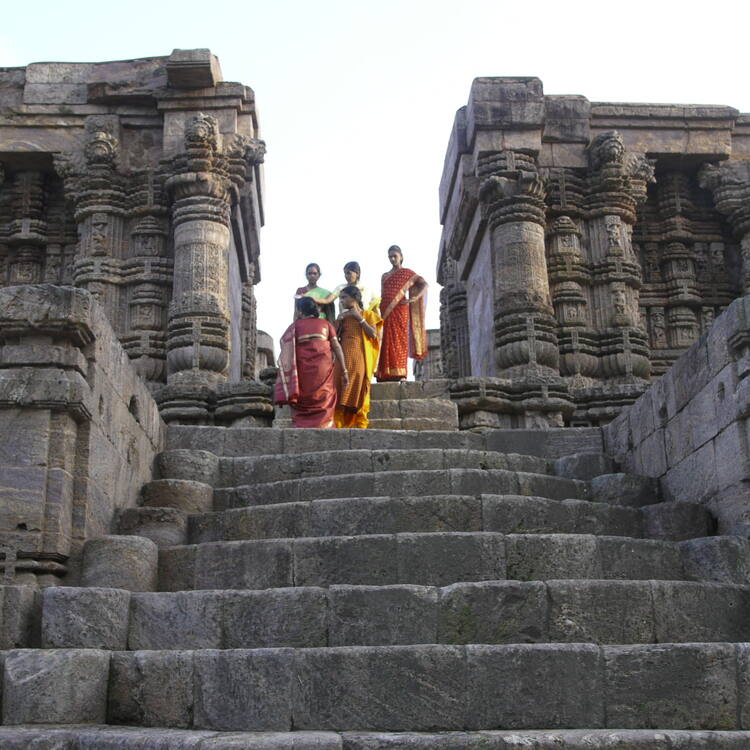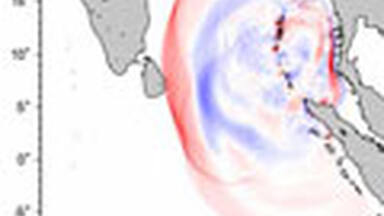Sun Temple, Konârak
Sun Temple, Konârak
On the shores of the Bay of Bengal, bathed in the rays of the rising sun, the temple at Konarak is a monumental representation of the sun god Surya's chariot; its 24 wheels are decorated with symbolic designs and it is led by a team of six horses. Built in the 13th century, it is one of India's most famous Brahman sanctuaries.
Description is available under license CC-BY-SA IGO 3.0
Temple du Soleil à Konârak
Au bord du golfe du Bengale, dans le prolongement des rayons du soleil levant, le temple de Konarak est une représentation monumentale du char du dieu-soleil Surya, aux vingt-quatre roues abondamment sculptées de motifs symboliques, et de son attelage de six chevaux. Construit au XIIIe siècle, c'est l'un des plus célèbres sanctuaires brahmaniques de l'Inde.
Description is available under license CC-BY-SA IGO 3.0
معبد الشمس في كوناراك
يشكّل معبد كوناراك الواقع على تخوم خليج البنغال في امتداد أشعة الشمس البازغة عرضاً تذكارياً لعربة إلهة الشمس ثريا بعجلاتها الأربعة والعشرين المنحوتة بوفرة بزخارف رمزية وبربطها ستة أحصنة. إنّ هذا المعبد الذي شُيّد في القرن الثالث عشر هو من أشهر المعابد البرهمانية في الهند.
source: UNESCO/CPE
Description is available under license CC-BY-SA IGO 3.0
科纳拉克太阳神庙
科纳拉克太阳神庙位于孟加拉湾沿岸,沐浴着冉冉升起的太阳。神庙依照太阳神苏利耶驾驶战车的样子建造。24个车轮饰有字符图案,6匹马拉着战车。这座神庙建于13世纪,是印度最著名的婆罗门庙宇之一。
source: UNESCO/CPE
Description is available under license CC-BY-SA IGO 3.0
Храм Солнца в Конараке
Освещаемый лучами восходящего солнца храм в Конараке на берегу Бенгальского залива – это монументальное воплощение колесницы бога Солнца – Сурьи, увлекаемой упряжкой из шести лошадей. Ее 24 колеса украшены символическими изображениями. Этот храм, воздвигнутый в XIII в., является одним из наиболее известных брахманских святилищ в Индии.
source: UNESCO/CPE
Description is available under license CC-BY-SA IGO 3.0
Templo del Sol en Konârak
Situado a orillas del golfo de Bengala y bañado por los rayos del sol naciente, el Templo del Sol es una representación monumental del carro del dios sol, Surya, con sus veinticuatro ruedas esculpidas con un sinfín motivos simbólicos y su tiro de seis caballos. Construido en el siglo XIII, este templo es uno de los más celebres santuarios brahmánicos de la India.
source: UNESCO/CPE
Description is available under license CC-BY-SA IGO 3.0
コナーラクの太陽神寺院
source: NFUAJ
Zonnetempel van Konârak
Langs de kustlijn van de Golf van Bengalen – badend in het licht van de rijzende zon – staat de tempel van Konârak. Het is een monumentale vertegenwoordiging van de triomfwagen van de zonnegod Surya. De 24 wielen van de wagen zijn versierd met symbolische ontwerpen en de kar wordt getrokken door zes paarden. Het is één van India’s meest beroemde brahmaanse heiligdommen en werd gebouwd in de 13e eeuw. Konârak is een bijzondere getuigenis van het 13e-eeuwse koninkrijk van Orissa. Het is direct en materieel verbonden aan het brahmaanse geloof en vormt een onschatbare link in de geschiedenis van de verspreiding van de Surya beweging.
Source: unesco.nl
सूर्य मंदिर, कोणार्क
बंगाल की खाड़ी के तट पर, सूर्य की किरणों से सराबोर, कोणार्क का सूर्य मंदिर सूर्य देवता के रथ का स्मारकीय प्रतिनिधि है। इसके 24 पहिए प्रतीकात्मक संरचनाओं से सुसज्जित हैं, इसमें 6 घोड़ो का समूह है। 13वीं शताब्दी में निर्मित, यह भारत के सबसे प्रसिद्ध ब्राह्मण पूजास्थलों में से एक है।
Source: India
Outstanding Universal Value
Brief synthesis
The Sun Temple at Konârak, located on the eastern shores of the Indian subcontinent, is one of the outstanding examples of temple architecture and art as revealed in its conception, scale and proportion, and in the sublime narrative strength of its sculptural embellishment. It is an outstanding testimony to the 13th-century kingdom of Orissa and a monumental example of the personification of divinity, thus forming an invaluable link in the history of the diffusion of the cult of Surya,the Sun God. In this sense, it is directly and materially linked to Brahmanism and tantricbelief systems. The Sun Temple is the culmination of Kalingan temple architecture, with all its defining elements in complete and perfect form. A masterpiece of creative genius in both conception and realisation, the temple represents a chariot of the Sun God, with twelve pairs of wheels drawn by seven horses evoking its movement across the heavens. It is embellished with sophisticated and refined iconographical depictions of contemporary life and activities. On the north and south sides are 24 carved wheels, each about 3 m in diameter, as well as symbolic motifs referring to the cycle of the seasons and the months. These complete the illusionary structure of the temple-chariot. Between the wheels, the plinth of the temple is entirely decorated with reliefs of fantastic lions, musicians and dancers, and erotic groups. Like many Indian temples, the Sun Temple comprises several distinct and well-organized spatial units. The vimana (principal sanctuary) was surmounted by a high tower with a shikhara (crowning cap), which was razed in the 19th century. To the east, the jahamogana (audience hall) dominates the ruins with its pyramidal mass. Farther to the east, the natmandir (dance hall), today unroofed, rises on a high platform. Various subsidiary structures are still to be found within the enclosed area of the rectangular wall, which is punctuated by gates and towers.The Sun Temple is an exceptional testimony, in physical form, to the 13th-century Hindu Kingdom of Orissa, under the reign of Narasimha Deva I (AD 1238-1264). Its scale, refinement and conception represent the strength and stability of the Ganga Empire as well as the value systems of the historic milieu. Its aesthetical and visually overwhelming sculptural narratives are today an invaluable window into the religious, political, social and secular life of the people of that period. The Sun Templeis directly associated with the idea and belief of the personification of the Sun God, which is adumbrated in the Vedas and classical texts. The Sun is personified as a divine being with a history, ancestry, family, wives and progeny, and as such, plays a very prominent role in the myths and legends of creation. Furthermore, it is associated with all the legends of its own artistic creation – the most evocative being its construction over twelve years using 1,200 artisans – and the stories about the deep commitment of its master builder, Bisu Moharana, to the project, in which his son (who was born during this period) later became involved. Konârak’s location and name are important testimonies to all the above associations, and its architectural realisation is associated with the living traditions of Brahmanismand tantricpractices.
Criterion (i): A unique artistic achievement, the temple has raised up those lovely legends which are affiliated everywhere with absolute works of art: its construction caused the mobilization of 1,200 workers for 12 years. The architect, Bisu Moharana, having left his birthplace to devote himself to his work, became the father of a son while he was away. This son, in his turn, became part of the workshop and after having constructed the cupola of the temple, which his father was unable to complete, immolated himself by jumping into space.
Criterion (iii): Konârak is an outstanding testimony to the 13th-century kingdom of Orissa.
Criterion (vi): Directly and materially linked to the Brahman beliefs, Konârak is the invaluable link in the history of the diffusion of the cult of Surya, which originating in Kashmir during the 8th century, finally reached the shores of Eastern India.
Integrity
The boundaries of the nominated property encompass the attributes necessary to represent the Outstanding Universal Value of the Sun Temple, Konârak. Within the inscribed and protected extent of the property, its surviving structures and sculptures, as well as the dislodged remains preserved in-situ, represent its quintessential qualities of architectural form, design and sculptural relief. Furthermore, the protected zone includes all areas that have the potential to reveal any unexplored archaeological remains that may possibly enhance the understanding of the property’s Outstanding Universal Value. Identified and potential threats to the integrity of the property include development pressure: modernisation and urban growth affecting the environment of the monument; environmental pressure: deforestation due to cyclones and human activities, saline breeze and sand blasting, vehicular movements, and microbiological growth; tourism pressure: 40% increase in number of tourists; natural disasters: flood and cyclones; and local population growth. An extension of the site boundaries and the buffer zone around the property by land acquisition has been recommended for the better management of the site. Concerns over the structural integrity of elements of the site have been raised in the past, including the impact of monsoon rains and associated soil erosion. In addition, erosion of metal cramps supporting the structure due to salt air has in the past resulted in some damage.
Authenticity
The Sun Temple’s authenticity of form and design is maintained in full through the surviving edifices, their placement within the complex, structures and the integral link of sculpture to architecture. The various attributes of the Sun Temple, including its structures, sculptures, ornamentation and narratives, are maintained in their original forms and material. Its setting and location are maintained in their original form, near the shore of the Bay of Bengal. In preserving the attributes as stated, the Sun Temple, Konârak repeatedly evokes the strong spirit and feeling associated with the structure, which is manifested today in the living cultural practices related to this property, such as the Chandrabhanga festival.
Protection and management requirements
The Sun Temple, Konârak is protected under the National Framework of India by the Ancient Monuments and Archaeological Sites and Remains (AMASR) Act (1958) and its Rules (1959). Other relevant protective legislation includes the Forest Act, Konârak Development Act and notified Council Area Act. Under the AMASR Act, a zone 100 metres outside the property and a further zone 200 metres outside the property constitute, respectively, prohibited and regulated zones for development or other similar activity that may have adverse effects on the Outstanding Universal Value of the property. All conservation programmes are undertaken by the Archaeological Survey of India through its national, regional and local representatives. There are five management-related plans: safety, environment, master planning, environmental development and tourism. World Heritage funding was received to carry out an assessment of structural stability.Sustaining the Outstanding Universal Value of the property over time will require continuing the structural and material conservation of the main Jagamohana structure and its sculptures; establishing a stronger functional integration of local and central authorities; including the larger landscape setting into the regulated area for development; and addressing the identified threats related to development pressure, environmental pressure, tourism pressure, natural disasters, and local population growth.

 View photos from OUR PLACE the World Heritage collection
View photos from OUR PLACE the World Heritage collection